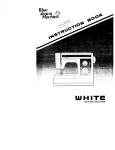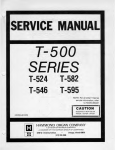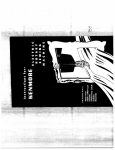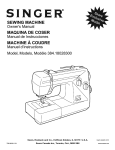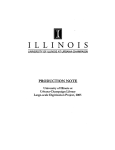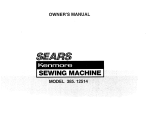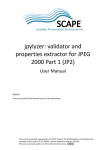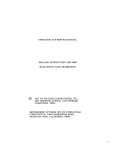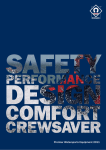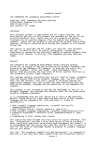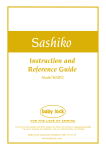Download Viking Turissa Service manual
Transcript
I We have published the Operation and Service Manual to aid you in the operation and minor service repairs of your new VIKING TURISSA SEW ING MACHINE. If. you carefully read this manual, you will be able to make use of all the sewing possibilities that are available to you. We hope you will enjoy your VIKING TURISSA and have many pleasant sewing hours. VIKING SEWING MACHINE CO., INC. I ieM,y I (Ci• Table of contents OPERATING MANUAL Accessory box Blindstitching Bridging Stitch Bringing up the lower thread Buttonhole Knife Buttonholes Changing the needle Changing the presser foot ‘ankle” Changing the srsapon presser foot Connection to electric outlet Correct and incorrect thread tension Darning Etastic straight stitch Extension plate Free arm Free .hand monograms and embroidery Insertion of bobbin case Lighting Lowering the feed dog Meiding and patching ::::: : :: ::: :::::: Needle position Qverlock stitch Pattern stitching Patterns and utility stitches Presser foot pressure control Regular presser foot Removing the bobbin case Reverse cycle patterns and utility stitches Ric rac stitch Roller presser foot 2 . 5 20 24 9 28 26 6 12 12 4 11 36 19 5 5 37 Selecting the stitch Sewing on buttons Shell stitch Straight stitching Tension of lower thread Tension of upper thread . Thread cutter Threading the lower thread Threading the upper thread Three step zigzag Twin needles Winding the bobbin Zigzag stitching Zipper presser foot . 14 29 25 15 10 10 10 S 9 22 7 16 30 4 13 34 SERVICE MANUAL 15 23 16 17 4 13 7 18 18 30 Belt tension Bobbinwincler adjustments Bobbinwinder wheel replacement Change needle Cleaning Light bulb Lubrication Maintenance hints Needle plate replacement Sewing hook clogged ..39 46 47 39 40 45 I 49 45 48 1. Bobbrn Winder Tension 2. Top Thread Guides 3. Thread Take-up Lever 4. Light Switch 5. Face Plate 6. Front Thread Guide 7. Upper Thread Tension Dial 8. Lower Thread Guide 9, Needle 10. Needle 11. Needle 12. Presser 13. Presser Clamp Thread Guide Bar Foot Screw 14. Presser Foot 15. Needle Plate 16. Free Arm 17 Shuttle Cover 18. 19. 20. 21. 22. 23. 24. 25, 26. Shuttie Thread Spool Pins Bobbin Winder Bobbin Winder Stop Handwheel Handwheel Release Stitch Width Selector Program Selector Transparent Indicator 27. 28. 29. 30. 31. 32. 33. 34. Setting Dot Reverse Feeding Lever Stitch Length Dial I-tote for Attaching Extension Plate Setting Dot Drop Feed Dial Base Plate Presser Foot Pressure Control Connection to electric outlet I A. Plug cord into foot control. B. Attach plug to machine. C. Plug cord into wall outlet. c A ‘I Lighting To turn light on or off, press button located on face plate. The light bulb is located inside the face plate. To remove the bulb, unscrew the bulb through the opening at the bottom of the face plate. ii Presser foot pressure control 1’ j 4 — The pressure control for the presser bar is lo cated on top of the machine on the left side. To change the pressure on the presser foot, press down on the outer ring. The inner section will move up. You now have no pressure on the presser foot. As you push down on the inner section you will increase the pressure. Loose pressure on the presser foot is used mostly for sewing on certain types of stretch fabric such as sweater fabric. Tight pressure on the presser foot is used for sewing girdle fabrics. Free arm Trouser legs and sleeves can be placed around free arm for easy mending, sewing or patching. The free arm also makes it much easier to attach collars and cuffs as well as sew small children’s clothes and darn stockings. Extension plate When you need a larger working surface, attach the extension plate. To install extension plate on machine, pull down the leg support, then position plate around free arm, pulling out catch on underside with right index finger. Make sure groove on back of extension plate fits around projected peg on back of sewing machine. Lock in place by releasing catch so it snaps into hole. — Accessory box The accessory box is located under the exten sion plate. To, remove the accessory box, pull the box to the left. 5 Needle and thread Cotton Sewing Thread Synthetic Thread No. No. 60 50--60 40--50 40 30 30 - Machine Embroidery Thread No. 50 30—50 30--50 Needle Width No. 70/10 80/12 90/14 100/16 110/18 120120 Synthetic threads are not generally numbered. Use a fine needle for fine thread and a heavier needle for heavier thread. Your sewing machine uses a type 705 or type 130 needle. This number refers to the length and configuration of the needle. It is best to purchase your needles from your dealer. How ever, if this is not possible due to some emer gency condition in your locality you can get by temporarily with what is commonly called a 15x1 needle which is carried in stock by almost all sewing machine stores or wherever they sell sewing machine needles. The above-mentioned needles come in various widths. And the larger the width number the larger the eye of the needle. With regard to the size of the needle it may be generally said that numbers 80/12 or 90/14 can be used for most fabrics. For a finer thread or for sheer or tightly woven fabrics a finer needle can be used. For a very heavy or stiff fabric a heavy needle can be used; the higher the needle number the heavier the needle. The sizes of thread and needle to be used are shown in the chart. Changing the needle Loosen the needle clamp screw and remove the needle. When you insert the new needle, turn the flat side away from you and push the needle up into the needle socket as far as the stop. Tighten the screw so that the needle is held firmly. 6 Removing the bobbin case Lift or remove extension plate. Bring needle to highest position by turning haridwheel to wards you. Open shuttle cover. Grasp bobbin case latch with thumb arid index finger and pull out bobbin case. Winding the bobbin With one hand hold handwheel stationary and use other hand to turn handwheel release (A) (turning towards you) to disengage sewing mech anism. Place empty bobbin on bobbin winder. Rotate bobbin on winder pressing down gently, until the notch on bobbin winder engages bobbin. Push bobbin towards handwheel and it will snap in position next to bobbin winder stop. Place spool of thread on spool pin. Guide thread through rear upper thread guide, around bobbin winder tension and wind thread around the bobbin a few times. Hold the end of thread while pressing foot control. Release end of thread as soon as winding process is underway. Bobbin winder stop will allow bobbin to fill completely. Now, •move bobbin away from handwheel; remove bobbin from bobbin winder and tighten handwheel release (by turning away from you). If you do not wish to completely fill your bobbin with thread, you may stop any time during the winding process by moving bobbin winder spindle to the left. 7 Threading the lower thread When bobbin is wound, hold it beside the bobbin case with thread running in direction of arrow in photo. Slide thread into the slot on edge of bobbin case as shown. Pull thread under tension spring. Check to b sure bobbin rotates in direction of arrow when thread is pulled. The hook on top of the bobbin case is used to increase the bottom tehsion when making buttonholes or when doing embroidery work. Before you insert the bobbin case, hook the thread on the hook on the bobbin case. Insertion of bobbin case Grasp bobbin case latch with thumb and index finger and place on shuttle spindle, with bobbin case opening on top or nearest the needle. Press bobbin case to make sure :it is locked in place. Release the latch. 8 II Threading the upper thread Raise presser bar. Turn handwheel until needle is in highest position. Place spool of thread on a spool pin (A). With circular motion, guide thread through upper thread guides, rear and front (B & C). Bring thread down and around tension dial (D). Now hold spool steady and pull end of thread upward and over to the right to lock thread into the thread tension spring. Insert thread through either eye of take-up lever (E). Place thread through front thread guide (F). Guide thread behind and through lower thread guide (G). Slip thread around left hook of needle thread guide (H). Thread the needle from the front to the back. Bringing up the lower thread Hold the threaded upper thread and turn the handwheel toward you until the needle goes down and then up again. When the needle is in its highest position, pull the upper thread and you will get a loop of lower thread which is easy to catch. You should not pull the upper thread too hard as this may bend the needle. Pull the threads (upper and lower) about 6” (15 cm) toward the rear. If thread ends are too short, the thread may slip out of the eye of the needle when you begin to sew. - 9 Thread cutter ? — / On the back of the presser bar you will find a notch, the thread cutter, which mak es it easy for you to cut off the threads. ç</ /•>-. Tension of upper thread The dial which regulates the tension of the upper thread is graduated from 0 to 5. Your machine has been tested with the thread which accompanies it. It may be nec essary to adjust the thread tension somewhat if you use thread of another thickness. For example, a heavier-tha n-ordinary sewing thread usually requires a higher upper thread tension. To increase the upp er thread tension, turn the dial to a higher number . Tension of lower thread 10 In most special sewing cases it is sufficient to change only the upper thread tension. Rarely do you need to adjust the lower thread tension. If it is necessary to adjust the tension of the lower thread, use the small scre wdriver from the accessory box. Fit it in the large r screw on the thread tension spring and turn it not more than 1/10th of a turn to the left if the thread tension is too tight; to the right if it is too loose. Correct and incorrect thread tension In order to easily understand the importance of correct thread tension, you can try different thread tensions by sewing two thicknesses of fabric. Begin by using an excessively loose tension, i.e. you turn the upper thread tension dial to the left as far as it will go. Look at the fabric and you will find the lower thread lies straight and the upper thread is drawn down into the lower side of the fabric. If you turn the dial to the right, the opposite occurs. The upper thread lies straight and the lower thread comes up in loops on the top of the fabric. The thread tension is correct when the threads interlock in the middle of the layers of fabric (approximately at 3 on the dial). Before starting to sew, check the tension by sewing on two thicknesses of the same fabric you intend to work with. Corrct Wrong Wrong Before you begin to use the zigzag stitch, check that the thread tension is the same as when you did straight stitching. Use a scrap of fabric to see how the zigzag stitches look if you set them first on the loosest (upper picture), then on the higher thread tension (middle picture). Then finally the correct thread tension will look about like that in the lower picture. It is important that you use the same weight thread on the bobbin as on the spool. ,-,.-- ‘<NN’— Correct \/\/\/\/\/\i\ 11 Changing the snap-on presser foot The presser feet which accompany the machine have the form of loose soles which are held in place on the presser foot “ankle” by a spring. To change the presser foot, turn the handwheel toward you until the needle is in the highest position. Remove the presser foot by drawing it toward you while pressing slightly down ward. Slide the new presser foot over the front edge of the ankle bracket as shown in the illustration. There is a spring on the lower end of the ankle bracket. Slide on the presser foot so that the round transverse pin on the presser foot fits into the space between the bracket and the spring. Then press lightly backward and down ward and the presser foot will snap into the correct position. Changing the presser foot ‘nkle” Certain presser feet cannot be constructed as loose soles and then the ankle bracket must also be changed. Make sure that the needle is in its highest position. Then loosen the re taining screw with your left hand and remove the presser foot ankle with your right hand. 12 Regular presser foot The presser foot (383) which is fitted on the machine at delivery, is used for normal straight stitching, zigzag stitching and other: utility stitches. As you can see, it has different notches which can be used as guides when sewing. If you wish to have a seam allowance about (6 mm), let the material run even with the outer edge of the presser foot (applies to straight stitching with the needle in the center position). By moving one step inwards you will have a seam allowance of about 5/32” (4 mm). The innermost notch gives a seam allowance of about 5/64” (2 mm). Upper side L-e- sce “ 2 4 7 Needle plate Exact seam allowances may be obtained by using guides on the needle plate which are measured from needle in CENTER position. Lowering the feed dog You lower the feed dog by turning the Drop Feed Dial to “crosshatch” symbol. To raise the feed dog turn the Drop Feed Dial to the symbol for a regular seam. Lower the feed dog when you sew on buttons, form closing bars (bar-tacks) and carry out certain darning work, embroidery, etc. 13 Selecting the stitch As you face the machine you wifl see two round controls. The one towards the top of the machine is the Stitch Program Selector. The outer scale is for selecting the needle position, the zigzag width and for making buttonholes. The middle scale is used for selecting various patterns. The inner scale is used for selecting various reverse cycle stitches. The red window indicates which function the machine is going to perform. The middle and inside scales are changed by moving the handle. The outside scale is moved by turning the outside scale. Remember to always turn the dial clockwise. The other control on the right of the machine is the Stitch Length Dial, the reverse cycle control and the control for sewing in reverse. 14 Straight stitching To make a regular straight stitch with the needle in the center position, turn the outer scale on the Program Selector so that the middle o is in the red window. Turn the pattern select or so that the symbol on the handle is aligned with the red window. Turn the Stitch Length Dial to 2. If you wish a longer stitch, move the control toward 5. If you want a smaller stitch turn toward 0. To sew in reverse, press down the lever located on the right of the Stitch Length Dial. When released, the machine will resume normal forward sewing. Needle position There are three needle positions: left, center and right. On the outer scale of the Program Selector you will see a scale from 0 5 in three different places. The scale with the letter E on top puts the machine in left hand needle posi tion (line on left). The middle scale puts the needle in center position. The third scale puts the needle in right hand position (line on right). - 15 Zigzag stitching Put needle in center position. Align the symbol on the handle with the red window. Move the outer scale and select the width required from to 5. The higher the number, the wider the zigzag. Select the length of stitch desired on the Stitch Length Dial. Zigzag stitches are mostly used for overcasting edges. Make sure that the needle sews over the edge of the fabric. A narrow zigzag stitch is also used for sewing tricot. You also use the zigzag stitch for embroidery work, sewing on buttons, snaps, etc. o Pattern stitching Upper Side Under Side /LJ When using the decorative stitches, change to the pattern foot. The pattern presser foot gives a more raised seam, thanks to the space behind the needle-hole on the underside, and should be used for all close pattern stitching and for close zigzag stitching. You will find the pattern presser foot in the accessory box. 16 II Patterns and utility stitches To obtain the patterns shown on the middle scale turn the outer ring to number 5, center needle position. Turn the handle so that the desired symbol on the middle scale is lined up with the red window. Set the Stitch Length Dial for buttonholes. The stitch length can be varied by turning the Stitch Length Dial. For decorative stitches we suggest that you loosen the top thread tension slightly so that the knots form on the bottom of the fabric. We also suggest that you put the bottom thread through the hook on the bobbin case. 1o —1 : Is I I j 1:1 III% I I , ‘‘blib I II’ % • I , I I ø I I I 1 .. ‘. I . I I — • I(••• • I I I% , 1% S% I %% I . • % 17 II Reverse cycle patterns and utility stitches The symbols for reverse cycle stitches are on the inner scale of the Program Selector. Turn the outer scale so that number 5 in the center position is in the red window. Turn the handle so that the desired symbol on the inner scale is lined up with the red window. To lock the machine in reverse cycle, hold down the reverse control and move the Stitch Length Dial towards the left so that the reverse cycle sewing symbol lines up with the dot on the machine. Be sure that when you finish using the reverse cycle stitch that you unlock the reverse mechanism by presssing down the reverse lever, and turn the Stitch Length Dial clockwise to 0. Release the reverse lever and set the stitch length at the desired point. >%i >I >% Ric rac stitch Setting for pattern No. 1 in illustration. Turn the outer scale on the Program Selector to 5, center needle position. Align the symbol on the handle with the red window. Set the Stitch Length Dial for reverse cycle. 8 F Elastic straight stitch Turn the outer scale on the Program Selector to 0, center needle position. Align the symbol on the handle with the red window. Set the Stitch Length Dial for reverse cycle. Press down on the reverse lever and turn the Stitch Length Dial to the left. . The elastic straight stitch is a triple lock straight stitch combining stretchability and strength. The stretchability makes it useful for sewing on knits and other stretch fabrics. It is also used for sewing crotch seams, sewing bias seams and for sleeve insertion. The elastic straight stitch can also be used for decorative purposes. Ill Ill Ill III Ill Ill Ill Ill III 19 II Blindstitching Turn the outer scale on the Proaram S&ector in so that No. 3 in the center needle position Is the that so handle the red window. Turn the ) lines up with the red blind hem symbol ( window. Set the Stitch Length Dial O 2:. Use blind stitch presser foot. is used• for hemming without on the right side. As you showing stitches the it consists of four sketch, will see from the straight stitches and one zigzag stitch. Blindstitching : I I I I S I 20 Fold the fabric as shown in the sketch. Both the length and the width of the stitches may have to be changed; it depends upon the fabric you are sewing. In the far left illustration can be seen how the stitches fail to reach the fold line of the fabric, indicating you should increase the stitch width. In the middle illustration the stitch width has been increased too much, leading to excessive “bite”, indicating you should decrease the stitch width. In the right illustration is shown how a correctly sewn blindstitched hem should look. The seam catches only one or two threads of the fold line. Three-step zigzag so Turn the outer dial on the Program Selector is tion posi le need r that number 5 in the cente the that so le in the red window. Turn the hand ) on the middle three-step zigzag symbol ( scale is lined up with the red window. Set the Stitch Length Dial on number 1.5. This is the most common size for the three-step zigzag. You can vary the stitch width and the stitch length according to the work you are doing. . 12 ‘.4—. .4— 44- ‘.4‘.422 Three-step zigzag has many advantages over ordinary zigzag when overcasting. It should replace the zigzag stitch when overcasting thin fabrics since ordinary zigzag may tend to cause the edge of the material to curt. Thick fabrics may be overcast twice with threestep in order to fasten the coarse threads in the weave. Three-step zigzag is even more elastic than or dinary zigzag. It should therefore be used for overcasting knit and stretch fabrics, if the seam is to be pressed open. Three-step zigzag is also used for sewing terry cloth, darning and mending. Overlock stitch Turn the outer dial on the Program Selector so that number 5 in the center needle position is in the red window. Turn the handle so that the symbol ( ) on the inner scale is lined up with the red window. Set the Stitch Length Dial on reverse cycle ( ). To lock the machine in reverse cycle, hold down the reverse lever and move the Stitch Length Dial towards the left so that the reverse cycle sewing symbol lines up with the dot on the machine. Be sure that when you finish using the reverse cycle stitch that you unlock the reverse mech anism by pressing down the reverse lever, and turning the Stitch Length Dial c’ockwise to 0. Release the reverse lever and set the stitch length at the desired point. .0 The overlock stitch is designed to sew together and overcast the edge in one operation: for ex ample when constructing a T-shirt, sweater, or in any place which calls for a %“ seam allow ance. li you wish, you can cut out the garment with a wider seam allowance. Sew the seam with the overlock (remember that the left-hand edge of the overlock should follow the seam marking) and then trim the remaining seam allowance along the stitches, as shown in the picture. 23 Bridging stitch Turn the outer scale on the Program Selector so that number 5 in the center needle position is in the red window. Turn the handle so tnat ) on the middle scale is lined the symbol ( up with the red window. Set the Stitch Length Dial between 1 2. ;-‘- - The bridge stftch is used for sewing girdle fabric, terry cloth, sewing on elastic and for mending and patching. 24 II Shell stitch Turn the outer dial on the Program Selector so that number 5 in the center needle position is in the red window. Turn the handle so that the symbol ( ). ) on the middle scaleis lined up with the red window. Set the Stitch Length Dial between 2 3. - The shell stitch is used to make a decorative hem in sheer fabric, especially nylon tricot. To obtain the shell effect, turn a narrow hem to the wrong side; sew the seam so that the zigzag stitch goes outside the folded edge. After you have finished the seam, trim the excess fabric from the wrong side close to the stitches. 25 Under Side Upper Side —r Buttonholes oe In order to sew buttonholes, you should chan will over to the buttonhole foot (284>. You hed attac is it and find it in the accessory box er in the same way as the regular snap-on press foot. In Loosen the upper thread tension slightly. the ing hook by on crease the bottom tensi . bobbin thread on the hook on the bobbin case The buttonhole will look better, if you use fine thread. Mark on the fabric where you want to place the buttonhole. Always test sew a buttonhole and adjust the stitch length setting. Begin as usual by making sure that the needle is in the highest position. Turn the outer scale on the Program Selector so that A is in the red window. Align the symbol on the handle with the red window. Set the stitch length on the buttonhole symbol. 26 S eww . . .—— •1 — — — — — —- - — first column of zigzag stitching in reverse. If the stitches are not sufficiently close, reduce the stitch length slightly. When you have sewn this column to the right length, stop the machine with the needle raised Out of the fabric and turn the dial to B. I I The next step is to form the first closing bar. Sew 3 4 stitches while holding back the fabric or lowering the feed dog. Then stop the machine with the needle raised out of the fabric and turnthedialtoC. . Now sew the other column of zigzag stitching the same distance as the first one. Stop the machine with the needle raised out of the fabric and turn the dial to 0. I I :, In position D the machine makes the final closing bar. Make 3 4 stitches while holding back the fabric or lowering the feed dog, stop ping the machine with the needle raised. Then turn the dial to E and lock the threads with a few stitches while holding back the fabric or lowering the feed dog. If you lowered the feed dog, make sure that you raise it after you have finished. - 27 I — __ Buftonhole knife C__ The buttonhole knife which you wW find in the accessory box, is equipped with a safety cap which, when taken off, can be pushed onto the back of the knife and thus provides a good handle. When you have finished sewing all of the button holes, it is time to Cut them open. Do this by piercing the fabric at right angles until tne curved edge reaches down to the buttonhole. Then incline the knife more or less parallel to the fabric and move it carefully forward so as not to cut through the end of the buttonhole. Helpful hint: You can also cut the buttonhole to the middle and then cut the same way from the other direction; or, place a pin at the end of the buttonhole so that you will not cut too far. 28 Sewing on buttons To sew on buttons, turn the outer scale on the Program Selector so that number 3 in left needle position is in the red window. Align the symbol on the handle with the window. Lower the feed dog. Use normal thread tension. Remove the presser foot, put the button in place and lower the presser bar. Set the Stitch Width Selector to a suitable setting--about 3; 1/6” most buttons have a spacing of 1/8” 4 mm) between the holes--turn the hand (3 wheel towards you and test carefully that the needle goes through the center of first one hole and then the other. Depress the foot control without disturbing the position of the button. Hold both thread ends behind the machine and sew 5 6 stitches. Then move to the other holes and repeat the process if using four-hole buttons. Set the Stitch Width Se lector to 0 and lock the thread. When the button has been sewn on, remember to raise the feed dog. - - - 29 Roller presser foot Upper Side Under Side The roller presser foot, is suitable for coarseknitted material and certain jersey and stretch fabrics as well as leather imitations and plastic materials. The grooved rollers give better friction against these materials. Zipper presser foot The zipper foot can be attached so that it comes either to the right or to the left of the needle. This makes it possible to sew on both sides of the zipper without turning the work. Usually instructions for inserting a. zipper are included when you purchase the zipper. How ever, you may find the following simplified method easier to follow. N 30 1. For this zipper application Ye” seam allowance is needed. Add if necessary. Sew the seam to notch for zipper opening. Baste the opening together with long stitches. 2. Press the seam open and remove the basting. 3. Make a stitching from the right side, 3/8” (1 cm> from one side of the opening. 4. Change to zipper foot. Place a piece of trans parent tape to the cloth edge of the zipper, on the wrong side, so that half the tape edge comes outside. 31 5. Take the side of the opening which i not stitched, and stick it to the taDe, puttinG the folded cloth edge as close as possibie to the chain of the zipper. Work from the right slOe. The tape will serve as basting. 6. Turn up the seam allowance. Sew in the fold (press crease), from the wrong side. Sew from the bottom up, continuing to the top of the zipper. 7. Remove the tape. 32 8. Place the other edge of the opening, where the stitching is, so that the cloth edge covers the zipper or chain. Tape together the open ing from the right side, starting from the bottom of the zipper. 9. Fold back the cloth and sew as close as possible to the stitching on the seam allowance. Sew from the bottom up. Open the zipper a little just before the seam is finished. It is easier to sew when the slide of the zipper doesn’t stand in the way. 10 Remove the tape and the zipper is attached. 33 Mending and patching s) LJ The three-step zigzag and the bridge stitch are the most suitable for mending and patching the majority of materials. This method is called “quick-mend”. The regular presser foot may be used. It is naturally better if the thread is of the same color as the fabric. The stitch length and stitch width should be adjusted to Suit the material. To start, try stitch length 1 2 and stitch width 4 5. - ‘I— When mending a rip, bring the edges of the fabric together and sew them together with three-step zigzag or bridge stitch. If necessary, reinforce the rip with a piece of fabric on the wrong side and sew back and forth once or twice. 34 When patching a hole, cut out the patch slightly larger than the damaged area. Place the patch on the right side; sew around all edges; sew a second seam inside the first seam. From the wrong side cut out the damaged area. A threadbare spot is repaired by sewing back and forth with three-step zigzag. Usethe reverse lever. For. every row of stitching, guide the fabric slightly to the side so that the stitches cover the entire worn area. If the fabric is very worn, a piece of the fabric or a lining may be attached to the wrong side of the material as reinforcement. Use bandage guaze as reinforcement material when mending table cloths, napkins and towels. •c < <. <c-< : ;> > > > — — -. <<,•< — ) C — > — <%ç >> — — > C :: _> <-<:< _>_> — >>,> < c 35 Darning Put the needle in its highest position and re move the presser foot ankle. Attach the darn ing foot to the machine making sure that the arm of the foot rests on the needle screw. Set the sewing machine for straight stitch as a wide zigzag stitch might break the needle. Drop the feed dog. Decrease the top thread tension slightly. Darning with the darning foot is done by free hand and, therefore, requires some practice. it is easier to darn if the fabric is stretched in a hoop. When stretched, the fabric should lie flat on the machine. Place the hoop under the darning foot. Lower the presser foot and bring up the lower thread. Begin by sewing back and forth over the hole with long stitches. Since the feed dog is dis engaged, you guide the hoop back and forth by yourself and thus determine the stitch length. The faster you move the hoop, the longer the stitch will be. Keep the machine speed uniform. Continue in the same manner until threads have been stitched across the entire hole. Then turn the work 9O’ and darn across the hole with short stitches which are obtained by moving the hoop slowly back and forth. Keep the machine speed uniform. if the hole is large, cover it with guaze and then darn as described above. Darning can also be done on the bias of the fabric or in circles if this would be better adapted to the structure of the fabric. 36 Free-hand monograms and embroidery Remove the presser foot including the ankle. Drop the feed dog. Set the Program Selector on the center needle position. The width of the zigzag stitch will depend upon how wide you wish the monogram to be. Loosen the top thread tension slightly. Hook the bobbin thread on the bobbin case hook. It is easier to monogram if the fabric is stretched tightly in a hoop. Place the work under the needle with the fabric touching the arm of the machine. Bring up the bottom thread. Re member to lower the presser bar so that you will have tension on the upper thread. For most people free-hand embroidery and monogramming requires some practice. Prac tice the technique by sewing circles and figures entirely by free-hand. First, sew once with a narrower stitch width and rather high speed on the machine. Then sew once again, this time with a slightly wider stitch which covers the first stitching. Move the work somewhat more slowly than the first time so that the stitches will be close together. Machine speed should be rather high. 37 Twin needles Twin needles are used for forming raised seams as well as for sewing decorative stitches using two threads. The twin needle is inserted in the same way as a regular needle. When using a twin needle you can use any design on the middle scale of the Program Selector. Make sure that the zigzag width is not set for more than 2; otherwise you will break the needle. Slowlymove the handwheel for an entire pattern so that you are sure the needle will not hit the needle plate. Also check the stitch length to be sure the stitches are not too close. Place a spool of thread on each spool pin. Thread both threads through the upper thread guides. Bring each thread around the tension dial with the threads on each side of the tension plate. Be sure to lock both threads in the tension spring. Insert each thread through separate holes in the take-up lever. Both threads go through the front thread guide but they sep arate at the needle thread guides. Iii 38 I Service manual A well-constructed sewing machine like the TURISSA usually does not need any major servicing as long as the machine is kept cleaned and oiled. Most problems are usually caused by a blunt or bent needle. Therefore, the first thing to do if the machine does not perform properly is to change the needle. Always use a new needle. Use System 130/705H. SERVICE MANUAL Change needle To change the needle, loosen the screw on the needle clamp. Remove the old needle by pulling down on the needle. Insert the new needle with the flat side facing away from you. Push the needle up as far as it will go and tighten the needle clamp screw. To make certain that the needle is correctly inserted always run your fingernail along the front of the needle; you should be able to feel the groove of the needle. When the needle goes down into the fabric the thread lies in this groove. If the needle is not correctly inserted with the groove facing you, the thread will break and no stitches will be formed. 39 Cleaning After you have been sewing for some time lint will collect around the bobbin case. When this occurs, remove the bobbin case and brush out the lint with a small brush. Make sure there is no lint or threads on the shuttle spindle. ____/ Occasionally the machine should be cleaned more thoroughly depending upon how much the machine is used and also on the type of fabric you are sewing. Some fabrics produce much more lint than others. if this lint builds up underneath the feed dogs the machine will not feed the fabric properly. Remove the needle and the presser foot. In order to get at the feed dogs, remove the top of the free arm. This is done by removing the screw located on the left of the top of the free arm. Remove the top plate by pulling to wards the left. Clean away any lint. Replace the top of the free arm. Make sure that you tighten up the screw properly so that the feed dogs will work correctly. When you are cleaning the machine, check the tension spring on the bobbin case to be sure there is no lint under the spring. This will cause incorrect tension. If there is lint under the spring remove it with the point of a pin or needle. 40 Lubrication In order to serve you satisfactorily, your new sewing machine will require oiling like all other precision products. Remember: It is important that you do not give the machine too much oil two drops at each lubricating point are sufficient. Too much oil does not give better results; the oil only runs out and may stain the fabric. NOTE: USE ONLY LIGHTWEIGHT, PET ROLEUM BASE, ACID-FREE OIL. This oil is provided in the accessory box that comes with the machine. If you should run out, you may obtain additional oil from your local dealer. Remove the two screws on the top cove r and remove the cover. Remove the needle and the presser foot. Remove the screw that holds the top plate of the free arm and remove the plate. Move the face plate and light out of the way. This is done by loosening but not remo ving the two screws which hold the plate. You get at these screws from the top of the mach ine. -< 2. o- • fl r4 0 ‘ — (n 0 -‘ Zr -. —CD Zr -< ZT (0 .-,C) C) Zr (D<O r Zr (D Zr Zr C) 0) V) x -4 (n t) Zr (03 C-. (000 Hc:tj o dl CD — CD0C) -. .<0 = 0. Zr C D. CD 0 CD 0 CD 3CD —U ‘ CD 0) -, 0 CD 2. 3 m 2. , CD3cL— tn Zr (flQ) do Ou — ..-+ woo T CD -‘ -. - -, CDCD - -‘ CD p cr -. -. 03(0 U) -+. .-+ -. 0) 03 CD O’ -‘ CD C CD CDc1 -‘ 0 03 CD .4 _ 0) 0iZ 03 C 1 < 0 C 0 <“ D 0 WD =- ot, 0 !P I” j4CD CD 0 r 0 +C0i - 0 __-., CD0) 0< C 0 C 0 - C 03 - o (fl C, , VI .< () CDC0OO — C CD < CD CD 0 -+ 0) CO ?c- - O z. CD :3__+ 0 0 2 oo_ -+ ‘-.. Di C 2. ! CD- < (0 x U) -+± CD O C — -e CD -, 0. ;c-_t O— rg CO :3- CD 0. 0 0. 0- C 0) (00 U) •g<0) s• CD ‘CD _•‘cn o 0) 0) -+‘_ -.gr Belt tension The belt goes from the motor to the machine and drives the machine. If the belt is slipping the machine will run slowly and if the belt is too tight it will also run slowly. To remove or adjust the belt, remove the four screws on the belt guard as the arrows indicate, remove the belt guard. EL: % Loosen screws “B,” Fig. 2. Slide Bracket “C” upward to relax tension on belt; downward to increase belt tension. Adjustment: Unthread machine; with machine running puth bracket “C,” down ward till machine speed is slug gish; move bracket “C” upward slowly till machine speed increases and tighten screws “B”. Note: 44 The belt equipment with this machine is made of a nonde teriorating material and is not affected by oil or age. Light bulb The light bulb is located inside the face plate. To remove the bulb, uns crew the bulb through the opening at the bottom of the face plate. LI I — K flN_ Needle plate replacem ent A bent or broken needle can damage the needle plate slot so that even with a new needle the thread will continue to break. To change the needle plate: Remove the needle and the presser foot. Remove the screw located on the left side of the top of the free arm plate. Slide out the free arm cover plate towards the left. Turn the plate upside down and remove the two screws on the nee dle plate. Insert a new needle plate making sur e the screws are replaced tightly. Replace the fre e arm cover plate. I, Under sde ‘\ (. 45 Bobbinwinder adjustments An incorrectly filled or overfilled bobbrn wiH cause uneven thread tension. If the bob b overfills, loosen set screw “A” Fig. 1, anc turn bobbinwinder stop clockwise. If bobbin winder stop disengages the bobbin prior to complete filling, turn counterclockwise. Note: The bobbinwinder should stop winding 1/32” (1 mm) from the outer edge of the bobbir.. The bobbin may wind unevenly as illustrated in Fig. 4. Turn the thread tension device, Fig. 2, clockwise with the aid of the large screwdriver until the winding becomes even as in Fig. 3. If the winding looks like Fig. 5, turn the thread tension device counterclockwise until the winding becomes even as in Fig. 3. 46 Bobbinwinder wheel replacement It is not likely that you will ever have to replace the bobbinwinder wheel, but if you do loosen screws “A” and remove machine top cover. Remove C-clip at point B; (this may be done with the large screwdriver included with attach ments) lift bobbinwinder frame “C” while holding spring “D” and remove. The rubber ring may be twisted or cut off; stretch new rubber ring over pulley. Reinstall bobbinwinder frame with spring; insure that the end of the spring engages slotted area of the bobbinwinder frame and mounting bracket. Attach C-clip. p 47 I Sewing hook clogged (machine locked) Remove the needle and unthread the machine. Rotate handwheel backwards (away from you). After sewing hook is free, remove any threads around the hook or around me shuttle spindle. Clean away any lint and oil the hook. 48 Maintenance hints Unattractive seams A. The needle is not correctly inserted. B. The needle is bent or blunt. C. The thread tension is incorrect. D. The machine is incorrectly threaded. E. The needle, thread and fabric do not correspond. F. The lower thread is not of the same quality or thickness as the upper thread. G. The bobbin is incorrectly inserted in bobbin case. H. Lint or thread is wrapped around the spindle of the sewing hook. I. Using incorrect sewing foot. J. The bobbin may be over filled, causing a tight lower tension. K. Bobbin wound unevenly. Needle breaks A. The needle is incorrectly inserted. B. You may have been pulling the fabric when sewing. The needle can easily de flect against the needle plate and be broken. C. Bobbin wound too full. 49 Upper thread breaks A. The needle is incorrectly inserted. B. The needle is bent or blunt. C. The needle groove or eye has too sharp of an edge. D. The needle and thread do not correspond. E. The needle plate slot is damaged and has sharp edges. F. The upper thread is incorrectly threaded. G. The upper thread tension is too tight. H. Poor quality thread may be knotted. I. Thread is entangled on the spool pin. - Lower thread breaks A. The bobbin case is incorrectly inserted. B. The lower thread is incorrectly threaded. C. The lower thread tension is too tight. D. The bobbin is wound too full. E. The needle plate slot is damaged and has sharp edges. F. Lint or thread is wrapped around the shuttle spindle. G. Bobbin is bent or has sharp edges. Lower thread not brought up by upper thread A. The needle is incorrectly inserted. B.. The needle is bent. C. Incorrect needle system: use System 130/705 H. 50 Uneven tensions A. Upper and lower threads not of same weight. B. The sewing thread is of poor quality. C. The needle, thread and fabric do not correspond. D. Thread tension, upper and lower may be unbalanced. Fabric puckers A. The upper thread tension is too tight. B. The upper and lower thread are of dif ferent thickness. C. The needle, thread and fabric do not correspond. D. The needle may be blunt. E. Using incorrect presser foot. Stitch length varies A. Using incorrect presser foot. B. The feed dog clogged by dust and lint. Skipped stitches A. Needle is incorrectly inserted. B. Needle is bent or blunt. C. Incorrect needle system; use System 130/705 H D. Upper thread incorrectly threaded. E. The needle, thread and fabric do not correspond. F. Using incorrect presser foot. G. Using different size and quality of thread for the upper and lower thread. 51 Machine does not feed fabric A. The stitch length dial set on 0; adjust 1 5. B. The feed dog is lowered, raise by turning the feed dog dial to the straight stitch symbol. C. The feed dog teeth are clogged with lint. D. Using improper sewing foot. E. Pressure on the presser foot released or too loose. - Machine does not sew the stitch indicated A. Controls have incorrect setting; refer to operating manual for correct stitch setting. Machine runs sluggishly A. The feed dog teeth are clogged with lint. B. Dirt or lint in the sewing hook or the bobbincase. C. The outlet voltage is too low. D. Drive-belt too tight or too loose. E. Oiling required. Machine will not run A. Hand wheel release not tightened. B. Bobbinwinder is engaged. C. Machine not plugged into electrical out let. 52





















































